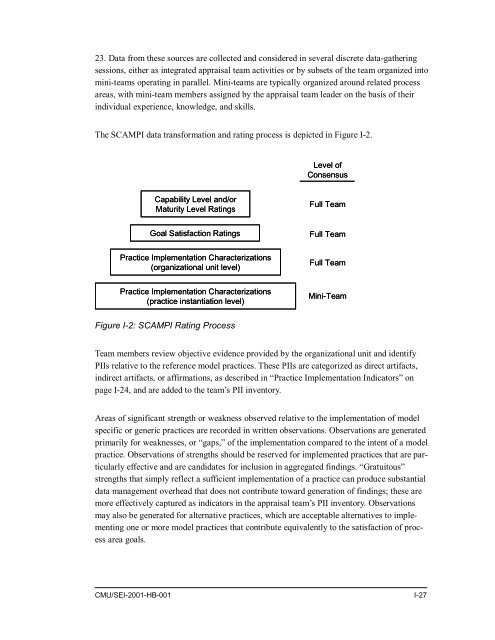Standard CMMI Appraisal Method for Process Improvement (SCAMPI)
Standard CMMI Appraisal Method for Process Improvement (SCAMPI)
Standard CMMI Appraisal Method for Process Improvement (SCAMPI)
Create successful ePaper yourself
Turn your PDF publications into a flip-book with our unique Google optimized e-Paper software.
23. Data from these sources are collected and considered in several discrete data-gathering<br />
sessions, either as integrated appraisal team activities or by subsets of the team organized into<br />
mini-teams operating in parallel. Mini-teams are typically organized around related process<br />
areas, with mini-team members assigned by the appraisal team leader on the basis of their<br />
individual experience, knowledge, and skills.<br />
The <strong>SCAMPI</strong> data trans<strong>for</strong>mation and rating process is depicted in Figure I-2.<br />
Level of<br />
Consensus<br />
Capability Level and/or<br />
Maturity Level Ratings<br />
Full Team<br />
Goal Satisfaction Ratings<br />
Practice Implementation Characterizations<br />
(organizational unit level)<br />
Full Team<br />
Full Team<br />
Practice Implementation Characterizations<br />
(practice instantiation level)<br />
Mini-Team<br />
Figure I-2: <strong>SCAMPI</strong> Rating <strong>Process</strong><br />
Team members review objective evidence provided by the organizational unit and identify<br />
PIIs relative to the reference model practices. These PIIs are categorized as direct artifacts,<br />
indirect artifacts, or affirmations, as described in “Practice Implementation Indicators” on<br />
page I-24, and are added to the team’s PII inventory.<br />
Areas of significant strength or weakness observed relative to the implementation of model<br />
specific or generic practices are recorded in written observations. Observations are generated<br />
primarily <strong>for</strong> weaknesses, or “gaps,” of the implementation compared to the intent of a model<br />
practice. Observations of strengths should be reserved <strong>for</strong> implemented practices that are particularly<br />
effective and are candidates <strong>for</strong> inclusion in aggregated findings. “Gratuitous”<br />
strengths that simply reflect a sufficient implementation of a practice can produce substantial<br />
data management overhead that does not contribute toward generation of findings; these are<br />
more effectively captured as indicators in the appraisal team’s PII inventory. Observations<br />
may also be generated <strong>for</strong> alternative practices, which are acceptable alternatives to implementing<br />
one or more model practices that contribute equivalently to the satisfaction of process<br />
area goals.<br />
CMU/SEI-2001-HB-001 I-27
















